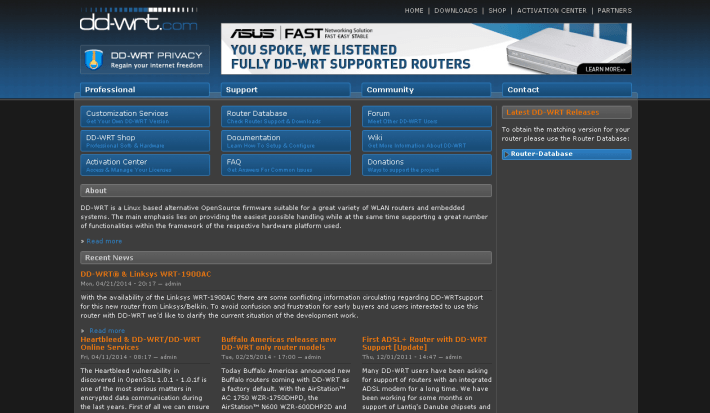Using a VPN (Virtual Private Network) is a huge step towards shielding your anonymity and protecting what is valuable for you online. However, there are some simple guidelines that you need to comply with, in order to make sure that your router is configured with VPN, such as HideMyAss. Since we’re Security Gladiators, we make use of a decent number of web security and anonymity tools for better protection and research on a daily basis (no matter if we’re in our office or even at home).
VPN is one of the most used tools even by our team (not just the readers), so we configured a VPN router to connect multiple devices at a time. We thought many people might need to do the same too, reasons behind that can vary a great deal though. Since we know how baffling this process can be, we have created this simple and yet effective guide as to what you ought to pay attention to, both prior to and during the configuration of your router. If you stick with the plan, you will see that everything is going to run smoothly and you will be over before you know it!
It is important to realize that there is abundant information as to how to configure your VPN router at the VPN provider’s website, with step by step procedures to be followed. What is equally important is for you to understand that not all the routers are compatible with your VPN and therefore you need to sort things out before proceeding with the purchase of a specific router.
Generally, a router that allows you to connect to the VPN without much fuss and without requiring flashing custom firmware is ASUS RT-N16. Besides that, Linksys E900 and E1200, ASUS N66U and AC66U are also fully functional and compatible with your VPN connection. The one we use and recommend is Asus RT-N16, in case you’re interested to know.
Table of Contents
How to Configure Your Router to HMA

- After having subscribed to HideMyAss (read the full HideMyAss review), what follows is the configuration of your router for obtaining the benefits of this VPN. Apart from a compatible router, you need to have the username and password for the PPTP servers of HideMyAss. If you do not have them at hand, you simply log in using the info you have been given from HMA (HideMyAss) and then click on the PPTP servers, till you reach these credentials. Write them down, because you are going to need them.
- Next step includes downloading DD-WRT firmware for your router. According to the router that you have purchased, you can find the download info on the Internet. This will help you out later on with the flashing of your router. If you’ve choosen Asus RT-N16 as your router, you can download the firmware from this link
- Now it is time for you to place the Ethernet cable that you have, in order to connect the router with your computer. At this point, make sure that there is no other cable connected to the computer and simultaneously check to see if there is any Wi-Fi in use.
- You open the browser on your computer and click on 192.168.1.1, so as to choose firmware upgrade. Pick the file that you had downloaded previously and start the flashing process.
Time for Setting up the Router
- If everything has gone according to plan, now you are at the main display of your router’s information and you are ready to complete the setup. Select the PPTP type of WAN connection and DHCP.
- Then, it is time for you to enter the IP address of the server you wish to connect to.
- Enter your username and password.
- Enable both PPTP Encryption and Disable Packet Reordering options.
- Disable STP and write down mppe required and stateless at the additional PPTP options.
- Save and you are done!
From then on, there are two different paths for you to cross; you can either use the Ethernet cable for connecting your router to the VPN or do that viag wireless. It is up to you and there is no significant protection differentiation between these two options. Nevertheless, if you use the wireless connection, it would be prudent for you to set up a password that protects the privacy of this connection. Of course, for further information as to how to configure and setup router for HideMyAss you can check through their support content.
The Basic Principle for Configuring Any Router
As a rule of thumb, you need the LAN IP of the VPN server you are going to use in your connection. You log in to the configuration page of your router and you get to the port forwarding screen, in order to make all the necessary adjustments for allowing the connection. You forward the VPN traffic using PPTP (or alternatively L2TP and OpenVPN). Fortunately, each and every single VPN provider has got tutorials and step by step guides that help you out remarkably, so that you can complete everything without fail.
As soon as you have pulled this through, you are ready to benefit from the superb advantages coming with the use of a VPN. In other words, as soon as you have configured and put your router into effect, you will be able to surf the web anonymously and use a remote IP address as your digital mark. You can see why it is of primary importance to clarify all the details that are related to the activation and configuration of any router; read through the instructions that you are given and have a look at our how-to guide, so that you route the traffic via the server of your choosing.
A whole new world full of potentials is unveiled before your eyes and you should take full advantage of the special features that will optimize your online experience. Feel free to share with us your thoughts on flashing and configuring any router, as well as ask any clarification you might need!
Top-right image by: HideMyAss (https://wiki.hidemyass.com/Router)


